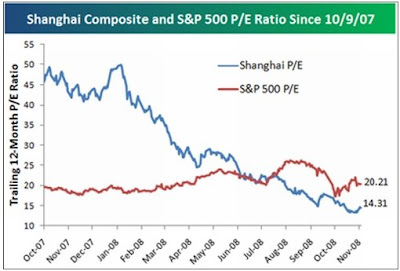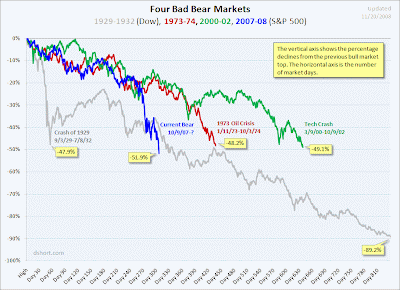Ha-Joon Chang defends trade protectionism, and he explains what he means by "forward looking protectionism". If you ask my opinion: no matter what fancy term you came up, protectionism is still protectionism. That's something we should best avoid talking about during the time of crisis, unless you want to have another Great Depression. I haven't read Chang's book. But simply linking Hamilton's merchanist policy in 19th century to the rise of US economy in modern times seems too suspicious to me.
By electing Barack Obama, US citizens have spoken – they not only want a more inclusive and less war-like country but one with different economic policies.
Many of Mr Obama’s economic policies are unlikely to prove contentious. Few would argue against tighter financial regulation, given today’s financial mess. Increased taxes for high-earners would be hard to oppose after the glaring absence of trickle-down from the Bush tax cuts – after all, the majority of the high-earners voted for him.
Mr Obama’s trade policy, however, is already causing controversy. He has vowed to protect American jobs and even argued for re-negotiating the NAFTA. There is already some hand wringing among free-trade economists, worrying that his protectionist policies may destroy the world trading system in the same way the infamous Smoot-Hawley Tariffs of 1930 did after the Great Depression. They counsel that the US should maintain its historical commitment to free trade.
However, contrary to what most people think, the US is the true home of protectionism. Between the 1830s and the 1940s, against superior European competition, the US developed its industries behind literally the highest tariff wall in the world, with the average industrial tariff rate ranging between 35% and 55%. Even the Smoot-Hawley Tariffs were not an aberration – the average US industrial tariff in 1931 was, at 48%, well within the historical range.
Moreover, the theory that justified such protectionism, namely, the ‘infant industry’ argument, had been first developed by none other than the first Treasury Secretary of the US – Alexander Hamilton (that’s the guy you see on the $10 bill). Hamilton argued that producers in relatively backward economies needed to be protected and nurtured through tariffs, subsidies, and other government policies before they mature and can compete with producers from more economically developed countries.
Of course, the protectionism that Mr Obama is advocating is protection to ease the adjustment of mature industries, rather than to promote infant industries. The case for such protectionism is not as overwhelming as that of infant industry protection. However, well-designed and time-bound protection of mature industries can facilitate, rather than hindered, trade adjustment and industrial upgrading. Japan and some European countries in the aftermath of the 1970s Oil Shocks come to mind.
Mr Obama should use protectionism in a similarly forward-looking way. Industries that can be revived through re-tooling of its factories and re-training of its workers should be given protection, but only if they fulfill certain conditions regarding investment and training. Industries that have no future should be given strictly temporary protection to ease phasing-out through orderly liquidation and redundancy.
A forward-looking protectionist strategy will also require a substantial strengthening of the welfare state in the US. A well-designed welfare state with good unemployment insurance and re-training programme can facilitate structural changes by reducing the resistance of the workers to more open trade that exposes them to greater risks. With such a welfare state, workers need not hold on to their current jobs, as it will help them maintain their standards of living during unemployment and find decent jobs in the future. Stronger welfare state is why the demand for protectionism is much weaker in the European economies than in the US, despite the greater acceptance of active role of the government in the former.
Keeping its market open is not enough for the US to play a genuinely positive role in the world trading system. The US should also stop pushing for trade liberalization in developing countries and give them the chance to use (intelligently-designed, of course) infant industry protection, which it invented and benefited so much from. Mr Obama should take a lead in creating a world trading system that allows asymmetric protectionism between the rich countries and the poor countries, with the latter protecting their markets more and gradually opening up in line with their economic development.
All these call for a much more activist role for the US government than it has been the norm. Providing protectionism to facilitate structural changes, and not just to protect existing jobs, would require a much closer coordination between trade policy and those policies to upgrade American industries, such as R&D support and worker training. Redesigning the welfare state as a vehicle to promote skills upgrading and labor mobility would push the US government into an uncharted territory.
These are big challenges. However, the US cannot continue its peculiar mixture of free-trade mythology and uncoordinated, ‘reactive’ protectionism that has served ordinary Americans and the developing nations so poorly.
Mr Obama has turned a new chapter in US history by becoming the country’s first Afro-American president. He will turn a new chapter in world history if he can come up with a forward-looking protectionist strategy that that both protects American jobs better in the long run and help developing countries develop faster.
Ha-Joon Chang teaches economics at the University of Cambridge. He is the author of Bad Samaritans (Random House and Bloomsbury Press).





